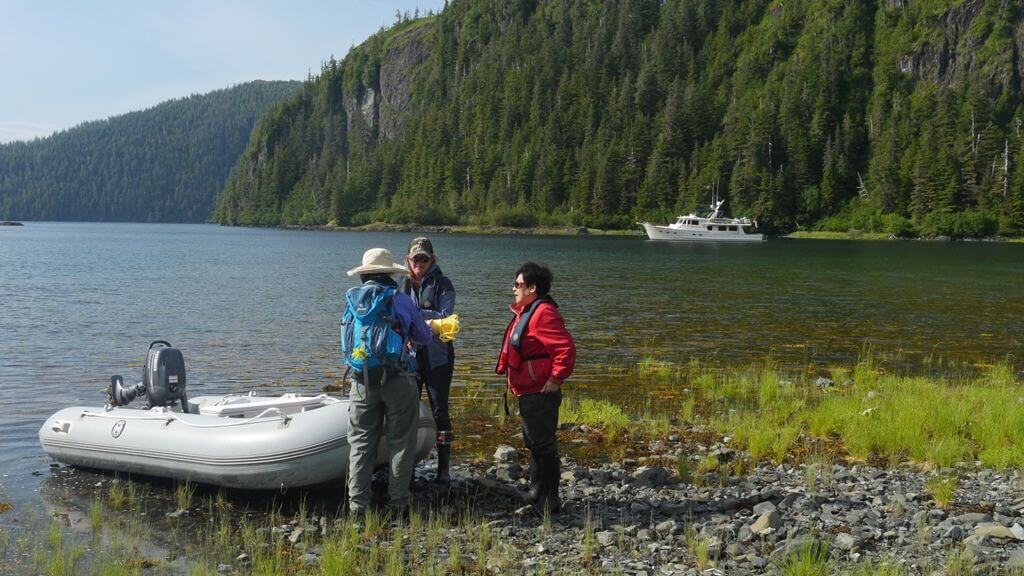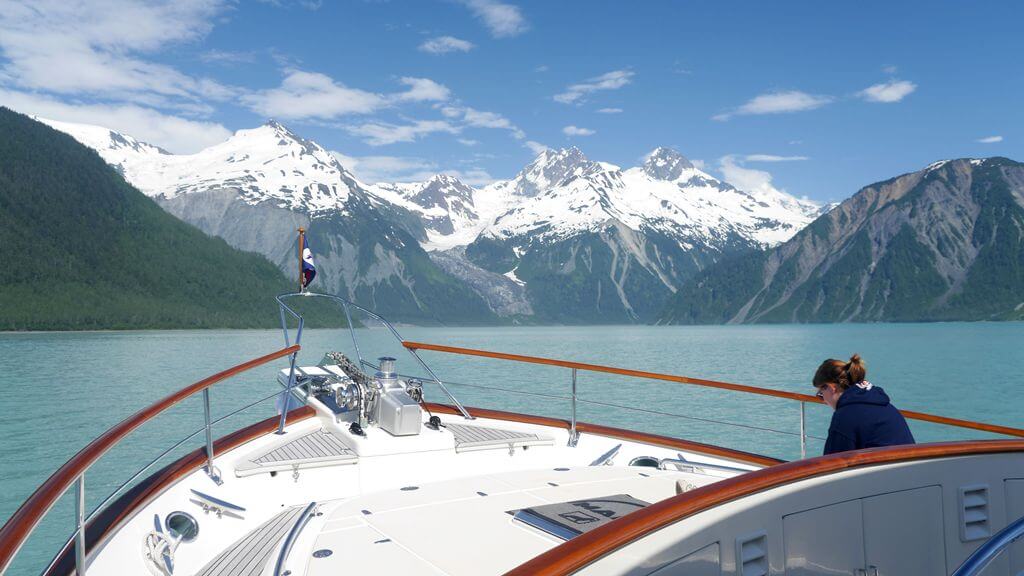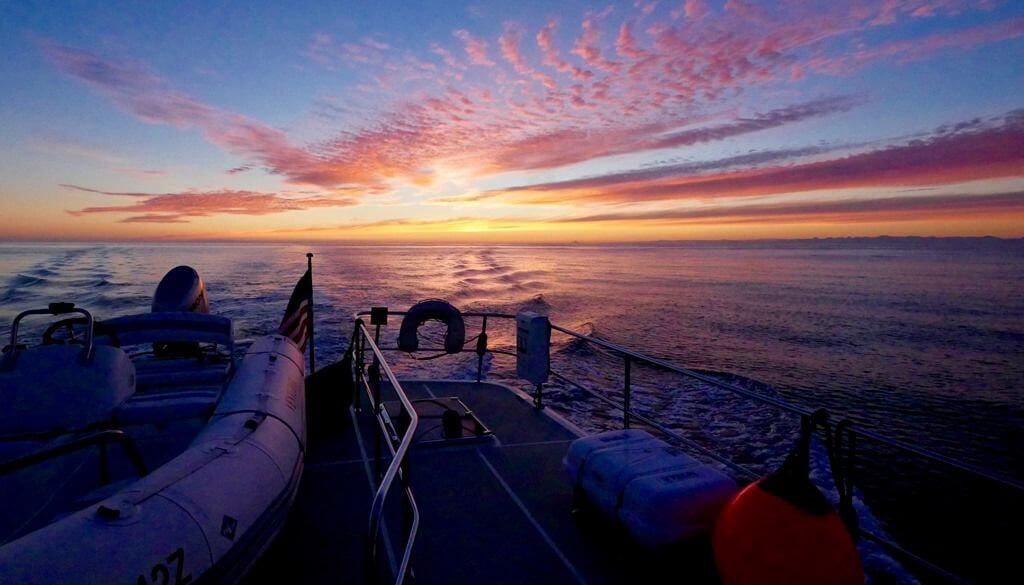IN COOK’S WAKE
Tony Fleming and his crew aboard his Fleming 65, Venture, travels to Prince William Sound, Alaska, and area with a turbulent and interesting past.
We watch in awe as jagged pinnacles of ice break free from their parent glacier and slide majestically into the water – the resulting mini tsunami undulates towards us across ice-strewn water. A vortex of spume whisks our inflatable away from the base of a thunderous waterfall. We paddle our kayaks through jade green waters, so thick with salmon they obstruct our passage. A sprinkling of memories that linger from a visit to Prince William Sound – the jewel in the crown of Pacific Northwest cruising.
Located 50 miles south east of Anchorage, it is no simple matter for the average cruising boat to reach this gem. We had departed from our base at Sidney on Vancouver Island on June 6th and followed the Inside Passage to Cape Spencer just west of the entrance into Glacier Bay. The next 400 miles require navigating the open waters of the Gulf of Alaska and, given its reputation as a breeding ground for nasty conditions, it’s essential to wait for a suitable weather window.
LITUYA-YAKUTAT
Our first stop, Lituya Bay, lies only 40 miles north of Cape Spencer. Its beauty harbours a sinister reputation. In 1958, ninety million tons of rock and ice broke loose from the head of the inlet creating a gravity wave a record 1720 ft high which stripped vegetation along the length of the bay to bare rock. Much earlier, in 1798, two skiffs and 21 men were lost while attempting to survey the treacherous entrance. LaPerouse the French admiral leading the expedition, named the island in the middle of the bay Cenotaph Island – meaning Empty Tomb.
Next stop is Yakutat from where, while awaiting a break in the weather, we take a day-long excursion to the Hubbard Glacier some 30 miles up Yakutat Bay. One of the very few glaciers bucking the trend by expanding instead of retreating, this glacier is six miles across and the largest in North America. The out-going tide allows us to approach within ¼ mile of the glacier face. We reverse course as the tide turns but leave it almost too late as the incoming flood brings with it quantities of floating ice which threaten to entrap us.

From Yakutat we head directly for Prince William Sound. Along the way we pass major landmark, Kayak Island, which projects well into the Gulf at dramatic Cape St Elias. This island was the site of Bering’s landfall in 1741 on what is now the Alaska coastline. Amazingly, after 10 years of preparation for his expedition, he spent only 10 hours here before heading back to Siberia. His ship was wrecked on the return journey and he is buried on the island that now bears his name. Quite by chance, Captain Cook also made landfall on the same island 37 years later during his search for the northwest passage aboard his ship Resolution.
5.5M TIDE RANGE
With an area of 7,000 square miles and a tidal range as much as 5.5m, enormous quantities of water flow in and out of the Sound – much of it through Hinchinbrook Entrance. A southerly gale meeting an ebb tide at this spot can turn this channel into a maelstrom so timing and conditions are all important.
We decide to head directly to Columbia glacier on the northern side of the Sound. We spend the night in a mirror calm anchorage where the surrounding mountains and even the flying gulls are reflected upside down in the still waters. During a previous visit to the Columbia in 2013, ice in the channel had prevented us from approaching or even catching sight of the glacier face. Today is a different story; under sunny skies we wend our way between myriad ice floes to within a safe distance of the face. We pass upwards of 30 sea otters hauled out on one floe with a similar number on another. Every animal warily watches our progress and we keep our distance.

The Columbia began its catastrophic retreat during the 1970’s – receding 10 miles in 25 years. The disastrous grounding of the Exxon Valdez on Bligh Reef in March 1989 was triggered by ice from this glacier blocking the outgoing ship channel, requiring the tanker to divert into the incoming channel. It was the failure to revert to the outgoing route in timely manner which caused the actual grounding. To see this for ourselves we decide to follow the tanker’s exact route over the reef – which we safely accomplish with 18m of water beneath Venture’s keel! The reef and nearby Bligh Island are named after William Bligh, later of Bounty fame. He was master of Cook’s ship Resolution when he visited the Sound in 1778. We do a drive by through Snug Cove where Cook careened and re-caulked his ships. Reportedly some planking seams had gaps 2 ½” wide and had to be caulked with rope!

SALMON FISHING FROM CORDOVA
We call at the town of Cordova which we have visited twice in the past. Fishing, on which the town depends, is rigorously controlled in Alaska. Fish farms are illegal and wild fish stocks are bolstered by those from hatcheries from which juvenile fish are released into the wild. Salmon returning from their time in the ocean are evaluated by aircraft, sample catches and even by counting individual fish as they make their way up rivers.
Based on the numbers, openings are allocated to different boats in different areas for specified times. We are lucky to have become friends with Robert who generously offers to take myself and crewmember David out on his boat. Known as a bowpicker, these boats can be trailered and operated by one person. Robert picks us up at 5 am and runs us out through shallow areas, known as the “flats”, to the designated area for an opening scheduled for 7am. At exactly that time – and not one second earlier – Robert deploys his net.

After an hour – much of which is spent trying to chase off a couple of seals munching on trapped salmon, the net is reeled in and fish retrieved and iced. This opening lasts 36 hours and, at intervals, the catch is delivered to strategically placed larger vessels called tenders, acting as collection points for the fish processors.
After five hours, David and myself are picked up by float plane and are returned to Cordova along with Rachel and Louisa by way of a forty minute flight over the Copper River Estuary and surrounding glaciers and jagged mountains.


Cordova is one of three significant towns in the Sound. It has Merle K (Mudhole) commercial airport but no road connecting it with the outside world. Valdez is the terminal of the Alaska pipeline and loading point for tankers taking crude from there to points south. In March 1964. Twenty-five years before the Exxon Valdez disaster – and also on a Good Friday – old Valdez was wiped out by a tsunami resulting from the Richter 9.2 earthquake which virtually destroyed Anchorage and many other towns.

Valdez was especially tragic. The town dock was crowded with residents and their children gathered to greet the first supply ship after the long winter when a huge wave, measured 20m high in nearby Shoup Bay, lifted the ship and dropped it down on the dock. No one on the dock survived. The town was moved to its present location on more stable ground.
An even higher wave hit the native village of Chenega killing 23 out of its 76 inhabitants. That village also has been relocated.
MILITARY OUTPOST
The third town, Whittier, was built as military outpost during WW2. It lies at the head of Passage Canal – which is actually not a canal as we normally understand it but a scenic, natural waterway. The town is surrounded by tall mountains and lies in the shadow of Whittier Glacier. The military bored a 4 km tunnel through Maynard mountain so, for many years, the town was only accessible by boat or rail. In 2000 a single track road was built which shares the tunnel with the railway. This road brings Whittier to within one hour of Anchorage. 75% of residents live in the one apartment block. Whittier has two marinas for which the waiting list is 14 years. Being unable to wait so long, we are instructed to side-tie alongside a venerable charter boat named Discovery. We are able to refuel here – the first since leaving Juneau – with fuel delivered to the town by rail. There are no facilities here for re-provisioning.
Whittier has no commercial airport but with its road and rail connections it is a calling point for cruise ships and the gateway to the scenic western side of the Sound. Names for many of the numerous glaciers and waterways in this area were coined by the 1899 Harriman Expedition. They named a major waterway College Fjord with Harvard and Yale Glaciers at its head. Side glaciers leading into the fjord were named after women’s colleges to the northwest and men’s colleges to the southeast.

We go first to Blackstone where melt water from hanging glaciers cascades in thunderous waterfalls past black cliffs patrolled by seabirds. Known locally as Deathtrap, walls of hanging ice lie out of sight of anyone at the base of the cliffs. Should they let go, the first – and last – you know about it is when tons of ice hurtle from the sky.
PACK ICE & GLACIERS
We head up College Fjord to Harvard Glacier and are surprised to see our Whittier dock companion, Discovery, surrounded by heavy pack ice in what, at first glance, seems to be perilously close to the face of the glacier. Distances are deceptive especially when it comes to glaciers. They appear to be within half a mile when the radar obstinately insists they are six times that distance.
We slowly nudge our way through dense but loose floes with the occasional thump and crunch. We pause to collect a piece of ice as clear as crystal that we plan to cool our drinks. Our slow progress is accompanied by cracks and booms from the glacier. I stand, with trigger finger on the camera button camera, ready to capture a significant calving. It’s a waiting game made less onerous by the latest equipment – shooting in 4K with a stabilised camera.
Over the following days we visit other glaciers: Bainbridge, Chenega, Cascade, Barry, Coxe and Surprise. The latter produces the most satisfactory calving but only after a wait of four hours. Along the way we encounter humpback whales feeding very close inshore. They float just beneath the surface. They are the masters of heavy breathing, their blows creating fountains of mist which hang, like specters, in the still air even after the animals have moved on.
We rendezvous with Bruce, a resident of Anchorage whom we met on a previous visit. Our vessels raft alongside in beautiful Barnes Cove on Knight Island. Bruce is an ardent fisherman and presents us with shrimp, halibut and salmon. We see three different black bears foraging along the shore.
Waterfalls are a predominant feature of Prince William Sound. The largest by volume is in aptly named Cascade Bay. We are able to anchor and take kayaks and the tender close to the base of the falls. Each time we travel to these northern latitudes there is less snow and the falls, although still impressive, lack the volume and splendor we record from past visits.
Less snow means less water and this is reflected in the flow from the streams, making it a greater challenge for returning salmon to make their way upstream. They congregate in staggering numbers waiting for high tide to ease their passage. Seals patrol the waters while bald eagles perch on the trees awaiting their chance to seize a returning fish.
The beauty of Prince William Sound is breathtaking but past disasters have left their legacies. The earthquake raised parts of the sound by as much as 1.6m and sank other areas by 2.5m. Salt water intrusion created cemeteries of dead trees known as Ghost Forests. There remains little visible evidence from the Exxon Valdez disaster but the lynchpin herring population has never recovered and the resident pod of orcas, who made the Sound their home, are doomed as they are down to just seven animals, none of whom is a breeding female.
After one month exploring its splendors we set out across the direct passage across the Gulf of Alaska stopping only to take photographs at Cape St Elias on Kayak Island.




